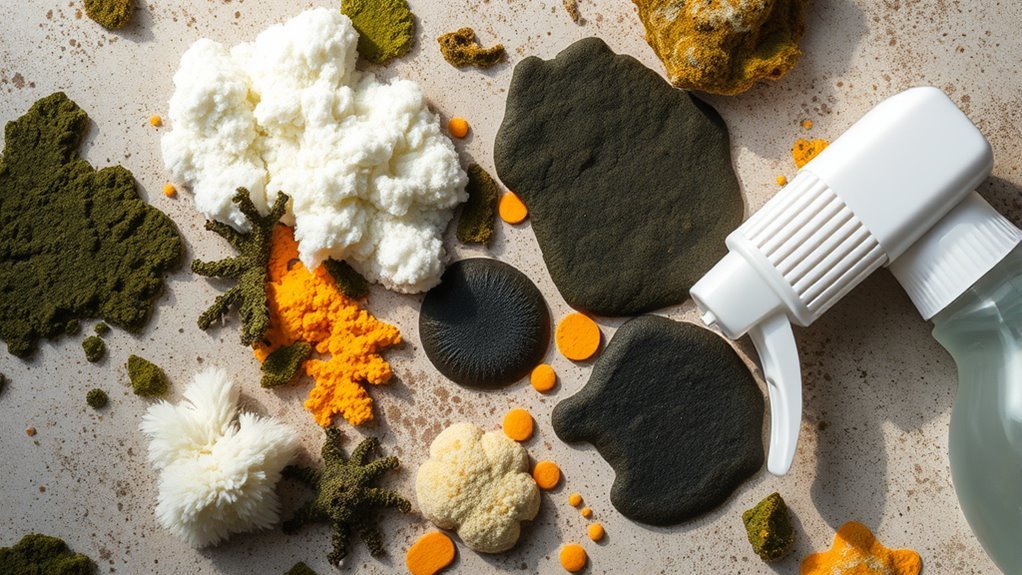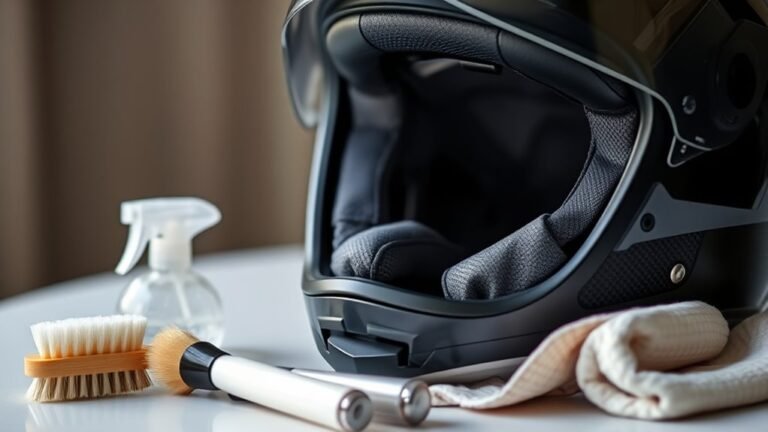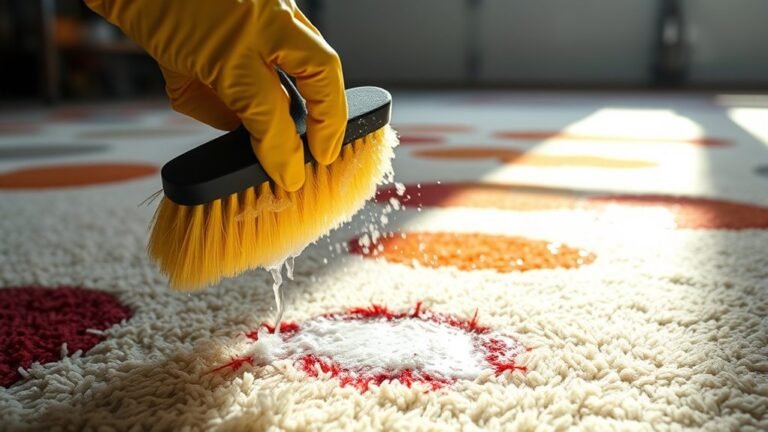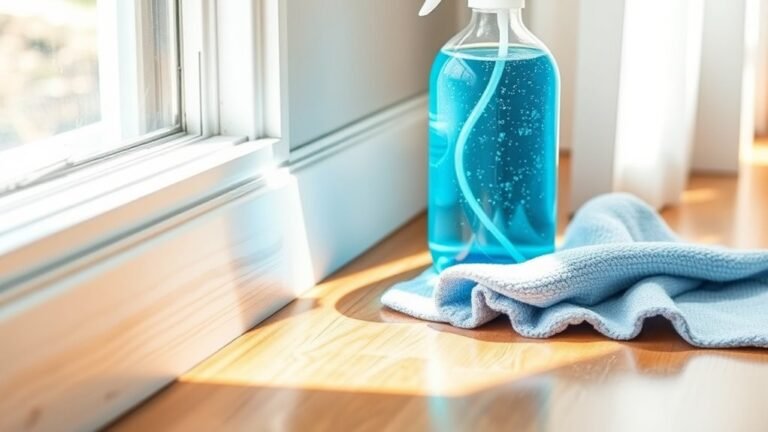How to Clean Mold
To clean mold safely, first wear gloves, a mask, and goggles to protect yourself from spores. Identify the mold type and ventilate the area well. Use mold-specific cleaners or diluted bleach and scrub gently to avoid spreading spores. Thoroughly dry the surface afterward to prevent regrowth. Porous materials might need replacement, while non-porous surfaces can be cleaned more easily. Proper prevention and knowing when to involve a professional are key—explore these steps to handle mold effectively and protect your home.
Identifying Different Types of Mold

Before you begin cleaning mold, it’s important to know how to identify the different types you might encounter. Mold comes in various forms—black mold, white mold, green mold, and more—each presenting unique health risks. Black mold, for example, is notorious for causing respiratory issues and allergic reactions, while other types may trigger milder symptoms. Understanding these types of mold helps you assess the severity of the problem and decide if you can handle the cleanup or need professional help. Pay attention to color, texture, and location; mold often thrives in damp, poorly ventilated areas. Recognizing the specific mold type is essential because some molds release mycotoxins harmful to your health. Stay informed so you can protect your freedom to live safely in your home.
Essential Safety Precautions Before Cleaning Mold
Before you start cleaning mold, make certain you wear protective gear like gloves, masks, and goggles to avoid exposure. You’ll also need to guarantee proper ventilation by opening windows and using fans to reduce inhaling mold spores. Taking these precautions helps keep you safe throughout the cleaning process.
Wear Protective Gear
Although cleaning mold might seem straightforward, you shouldn’t underestimate the importance of wearing protective gear to safeguard your health. Mold spores can easily irritate your respiratory system and eyes, so using protective masks is essential to prevent inhaling harmful particles. Make sure your mask fits snugly and is rated to filter out mold spores effectively. Safety goggles are equally important to shield your eyes from airborne spores and cleaning chemicals. Avoid contact lenses during cleaning, as they can trap spores. Wearing gloves and long-sleeved clothing further minimizes skin exposure. Taking these precautions isn’t about restriction—it’s about empowering you to clean mold safely and confidently, protecting your freedom to maintain a healthy living environment without risking illness or irritation.
Ensure Proper Ventilation
How can you make certain you’re not breathing in concentrated mold spores while cleaning? Proper ventilation is key. Without it, spores can linger in the air, posing health risks. Use effective ventilation techniques to maintain clean air circulation throughout the space.
Here’s how to guarantee proper ventilation:
- Open windows and doors to create cross-ventilation, allowing fresh air to flow in and stale air to exit.
- Use fans strategically—place one near an open window facing outward to push spores outside, and another inside to circulate air.
- Avoid using HVAC systems during cleaning, as they can spread spores to other rooms.
Gathering the Right Cleaning Supplies

Since mold can pose health risks, you’ll need to gather specific cleaning supplies that protect you and effectively eliminate the growth. Start by selecting appropriate cleaning products designed for mold removal, such as fungicidal sprays or diluted bleach solutions. Avoid harsh chemicals that could harm your health or damage surfaces. Next, equip yourself with essential mold removal tools: a stiff brush for scrubbing, sponges for wiping, and disposable gloves to shield your skin. A mask or respirator is vital to prevent inhaling spores. Don’t forget safety goggles to protect your eyes. Having a sturdy plastic bag nearby helps you safely dispose of contaminated materials. By assembling these cleaning products and mold removal tools, you guarantee a safer, more efficient mold cleanup, allowing you to reclaim your space without unnecessary risk.
Preparing the Affected Area for Mold Removal
Before you begin cleaning, you’ll want to prepare the affected area carefully to prevent mold spores from spreading further. Proper affected area preparation is essential for effective mold removal and your safety. Start by sealing off the space; close doors and windows, and use plastic sheeting to isolate the area. Next, turn off any HVAC systems to avoid distributing spores throughout your home. Finally, gather your mold removal tools—gloves, masks, and appropriate cleaning agents—to handle the mold safely.
- Seal off the area with plastic sheeting
- Turn off HVAC systems to prevent spore spread
- Collect all necessary mold removal tools
Step-by-Step Mold Cleaning Process

Before you start cleaning, make certain you can accurately identify the mold type to choose the safest and most effective method. Using proper techniques and cleaning solutions is essential to prevent spreading spores or causing health risks. Follow each step carefully to guarantee thorough removal and avoid recurring growth.
Mold Identification Techniques
How can you be certain that the discoloration on your walls is mold and not just dirt or paint damage? Identifying mold growth accurately is vital before you start cleaning. Mold thrives in damp areas, so first check for mold sources like leaks or condensation. Here’s how to identify it:
- Visual Inspection: Look for black, green, or white fuzzy spots, often in clusters, especially in moist areas.
- Smell Test: Mold often emits a musty, earthy odor distinct from regular dust or dirt.
- Surface Test: Lightly rub the spot with a damp cloth—if it smears and the area feels slimy or soft, it’s likely mold.
Confirming mold guarantees you address the root problem safely, preserving your freedom from ongoing contamination.
Effective Cleaning Methods
Cleaning mold effectively involves a few critical steps that you must follow carefully to guarantee complete removal and prevent regrowth. First, protect yourself with gloves, goggles, and a mask. Next, ventilate the area to reduce exposure to mold spores. Choose appropriate mold cleaning products designed for the surface you’re treating. Apply the product generously and allow it to sit as directed, breaking down mold colonies. Use a scrub brush or sponge to remove mold, employing effective mold removal techniques like scrubbing in circular motions. Rinse thoroughly and dry the area completely to eliminate moisture, which fuels mold growth. Finally, dispose of cleaning materials safely to prevent spreading spores. Following these steps assures you regain control over your space and maintain your freedom from mold’s harmful effects.
Dealing With Mold on Porous vs. Non-Porous Surfaces
Although mold can grow on many surfaces, the approach you take depends greatly on whether the material is porous or non-porous. Porous surfaces, like wood or fabric, absorb moisture and mold spores, making removal tougher. Non-porous surfaces, such as glass or metal, don’t absorb mold, so cleaning is usually more straightforward.
Mold removal varies by surface type: porous materials absorb spores, while non-porous ones are easier to clean.
Here’s how to tackle each:
- Porous surfaces: You’ll need to scrub thoroughly and may have to discard items if mold penetrates deeply.
- Non-porous surfaces: Wiping with a mold-killing cleaner often suffices.
- Always wear protective gear and guarantee good ventilation regardless of surface type.
Understanding the difference lets you act decisively, preventing mold from spreading or returning.
Using Natural Remedies to Combat Mold
After recognizing the type of surface you’re dealing with, you might want to contemplate natural remedies as an alternative to chemical cleaners. Natural ingredients like white vinegar, tea tree oil, and baking soda offer effective, eco friendly solutions to combat mold without harsh chemicals. Vinegar’s acidity helps break down mold spores, while tea tree oil’s antifungal properties inhibit growth. Baking soda not only cleans but also deodorizes affected areas. When using these remedies, apply them directly to the moldy surface, let them sit for at least an hour, and then scrub gently. Keep in mind, natural solutions may require repeated applications and aren’t always a substitute for professional treatment on extensive mold. Always wear protective gear and guarantee proper ventilation to safeguard your health while cleaning.
Preventing Mold Regrowth in Your Home
To keep mold from coming back, you’ll need to control moisture levels and improve ventilation throughout your home. Mold thrives in damp, poorly ventilated spaces, so staying proactive is crucial. Here’s how you can prevent mold regrowth effectively:
- Use mold resistant materials during repairs or renovations, especially in areas prone to moisture like bathrooms and basements.
- Maintain proper humidity control by using dehumidifiers or air conditioners to keep indoor humidity below 60%.
- Guarantee good airflow by opening windows regularly and using exhaust fans in kitchens and bathrooms to reduce moisture buildup.
When to Call a Professional Mold Remediation Service
If you notice mold spreading extensively or suspect it’s hidden behind walls or under floors, it’s time to call a professional mold remediation service. A thorough mold assessment is crucial to identify the full scope of contamination and any potential health risks. Attempting to remove large infestations on your own can be dangerous and may spread spores further. Professional services have the expertise, tools, and safety equipment to handle mold safely and effectively. They also address underlying moisture problems to prevent regrowth, giving you true freedom from recurring issues. Don’t wait—when mold impacts your living space considerably, relying on experts guarantees a thorough, lasting solution rather than a temporary fix. Protect your home and health by knowing when to seek professional help.
Frequently Asked Questions
Can Mold Cause Allergic Reactions or Health Issues?
Yes, mold can cause allergic reactions and other health effects that you shouldn’t ignore. If you’re exposed to mold, you might notice mold symptoms like sneezing, coughing, or skin irritation. Some people experience more severe issues, including respiratory problems or asthma flare-ups. It’s important to recognize these health effects early and take action, so you don’t compromise your well-being or freedom to live comfortably in your space.
How Long Does Mold Typically Take to Grow?
Imagine mold growth as a secret garden sprouting overnight—if conditions invite it. Typically, mold growth timeline starts within 24 to 48 hours when moisture and warmth meet. Environmental factors like humidity, temperature, and organic materials fuel this rapid spread. You can’t always see it immediately, but it’s quietly claiming space. Stay vigilant; allowing mold to flourish unchallenged can trap your freedom in health and home issues you didn’t expect.
Does Humidity Level Affect Mold Growth?
Yes, humidity level directly affects mold growth. When humidity is high, mold thrives by feeding off excess moisture in the air. To keep mold at bay, you need to focus on humidity control and eliminate moisture sources like leaks or poor ventilation. Without managing these factors, mold can spread quickly, limiting your freedom to enjoy a healthy, clean space. Stay vigilant and maintain dry conditions to protect your home.
Can Mold Grow Behind Walls or Under Flooring?
Yes, mold can definitely grow behind walls or under flooring where moisture sneaks in unnoticed. Since mold detection in these hidden spots is tricky, you’ll need to watch for musty smells or discoloration on surfaces. Prioritizing moisture control is essential to stop mold growth before it spreads and causes damage. You’ve got the freedom to maintain a healthy space, but staying vigilant and addressing leaks promptly is key to keeping mold at bay.
Are Certain Building Materials More Resistant to Mold?
Like a fortress standing strong against invaders, mold resistant materials shield your space from unwanted growth. Certain building material types, like treated wood, metal, and mold-resistant drywall, are designed to repel moisture and inhibit mold development. You’ll want to choose these wisely to keep your home healthy and free, but remember, no material is completely foolproof—proper ventilation and moisture control are essential to truly defend your sanctuary.






